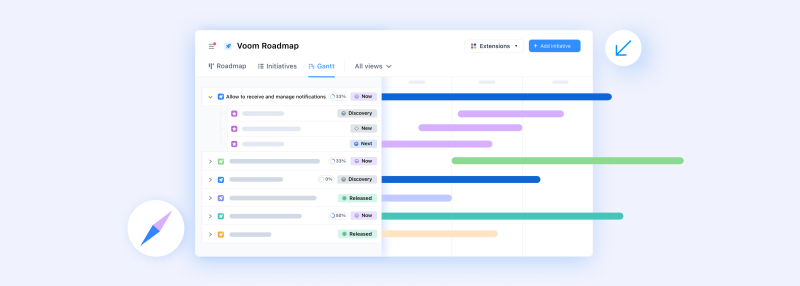Effective vs. Ineffective Release Plans - With Examples and Template

A release plan is a document that outlines the features and enhancements that will be delivered in a specific release of a product. It helps product managers communicate the value and scope of the release to stakeholders, align the team on the goals and priorities, and manage the risks and dependencies involved in the development process.
However, creating an effective release plan is not an easy task. It requires a lot of research, analysis, collaboration, and iteration.

Challenges faced by product managers when creating a release plan
Balancing resources and timelines: Product managers need to estimate how much time and effort each feature will take, and allocate resources accordingly. They also need to set realistic deadlines and account for possible delays or changes.
Incorporating stakeholder feedback: Product managers need to gather and prioritize feedback from various stakeholders, such as customers, users, executives, developers, testers, and marketers. They also need to manage expectations and communicate the trade-offs involved in the release plan.
Managing dependencies: Product managers need to identify and resolve any dependencies between features, teams, or external factors. They also need to plan for contingencies and mitigate any risks that might affect the release.

What is an ineffective release plan?
A counter-example of an ineffective release plan is one that:
Lacks a clear vision, goals, scope, or schedule for the release
Does not consider or address the feedback or needs of the stakeholders or customers
Does not account for or mitigate the risks or dependencies involved in the release
Does not use any tools or software to organize, visualize, or track the release progress
Does not follow any templates or best practices to structure or format the release plan document
An example of such a release plan is:
Release Plan for Product X
We are going to launch Product X in Q3. It will have some cool features that we think customers will like. Here are some of them:
Feature A: This feature will do something awesome.
Feature B: This feature will do something else awesome.
Feature C: This feature will do something even more awesome.
We will work on these features as fast as we can. We don’t have a fixed timeline or budget for them. We will just see how it goes.
We don’t need to worry about what other teams or stakeholders think. We know what we are doing. We don’t have any dependencies or risks that might affect our release. We don’t need any tools or software to help us with our release plan. We just need a simple document like this one.
That’s it. That’s our release plan for Product X. We hope you like it.
This lacks vision, doesn’t talk about stakeholders or customers, isn’t organized, and ignores all the best practices.
Fortunately, some strategies and tools can help product managers create an effective release plan. Here are some examples and templates that you can use to inspire your own release plan.

Examples of effective release plans
One way to learn how to create an effective release plan is to look at how other successful companies do it. Here are some examples of two companies, Microsoft and Atlassian that have built an effective release plans for their products:
Microsoft: Microsoft uses a release plan template that consists of four sections: vision, goals, scope, and schedule. The vision section describes the overall purpose and value proposition of the release. The goals section defines the specific outcomes and metrics that the release aims to achieve. The scope section lists the features and enhancements that will be included in the release, along with their priority and status. The schedule section outlines the timeline and milestones of the release, along with any dependencies or risks.
Atlassian: Atlassian uses a release plan template that consists of three sections: why, who, and when. The why section explains the problem or opportunity that the release addresses, along with the benefits and results expected. The Who section identifies the target audience and stakeholders of the release, along with their needs and feedback. The when section specifies the date and frequency of the release, along with any assumptions or constraints.

Tools and software for creating an effective release plan
Another way to create an effective release plan is to use tools and software that can help you organize, visualize, and track your release progress. Here are some examples of tools and software that you can use to create an effective release plan:
airfocus: airfocus offers a release plan template along with a step-by-step guide on how to create it, and best practices for having a successful plan. It's important to note that release plans are not set in stone, they need to change and adapt to the changing data, needs, and resources of the team and different stakeholders; airfocus allows you to do just that, with its modular platform built to give you flexibility without any wasted time.
Jira: Jira is a project management software that allows you to create and manage releases using agile methodologies. When connecting Jira with your roadmap, you can do a deep dive into particular features and have all the information in one place.
Asana: Asana is a work management platform that allows you to create and manage releases using various views such as lists, boards, timelines, calendars, or portfolios. Asana has great tools that work with time dependencies, can work with different projects easily, and is more likely to be used by teams outside of engineering, so there are paths to communication there.
Trello: Trello is a collaboration tool that allows you to create and manage releases using cards, lists, and boards. This is the easiest option to use. It makes up for what it is missing in features in ease of use.
Of course, these tools are more effective when used in conjunction with an airfocus roadmap. You can find a list of our integrations(which include the three tools listed above) here.
Templates for creating an effective release plan
To create an effective release plan you can use templates that can help you structure and format your release plan document. Here are some examples of templates that you can use to create an effective release plan:
Gantt chart: A Gantt chart is a type of bar chart that shows the start and end dates of each feature or task in a release. It also shows the dependencies and progress of each feature or task. You can use a Gantt chart to visualize and manage your release schedule and resources.

Kanban board: A Kanban board shows the features or tasks in a release as cards that move across different columns or stages. It also shows the priority and status of each feature or task. You can use a Kanban board to organize and track your release workflow and progress.
A release plan is not a roadmap
It’s important to recognize that a roadmap and a release plan are not the same thing.
A roadmap is a communication tool designed to help the viewer understand the strategy and themes of the company. A roadmap shouldn't talk about direct features and timelines, since it is a public document and these things change on a regular basis.
When teams confuse a roadmap for a release plan, they will lose trust, as items on a release plan are often ready to go before the release plan is communicated, so the risk of change is low, versus a roadmap where the risk of change is high.
Conclusion
Building an effective release plan is a crucial skill for product managers. It helps them communicate the value and scope of the release to stakeholders, align the team on the goals and priorities, and manage the risks and dependencies involved in the development process.
However, creating an effective release plan is not an easy task. It requires a lot of research, analysis, collaboration, and iteration. Product managers face many challenges when planning a release, such as balancing resources and timelines, incorporating stakeholder feedback, and managing dependencies.
To overcome these challenges, product managers can learn from the examples and templates provided in this article and implement the strategies and tools discussed to create their own effective release plan. By doing so, they can deliver products that meet customer needs, solve business problems, and achieve market success

Adam Thomas

Read also






Experience the new way of doing product management

Experience the new way of doing product management



